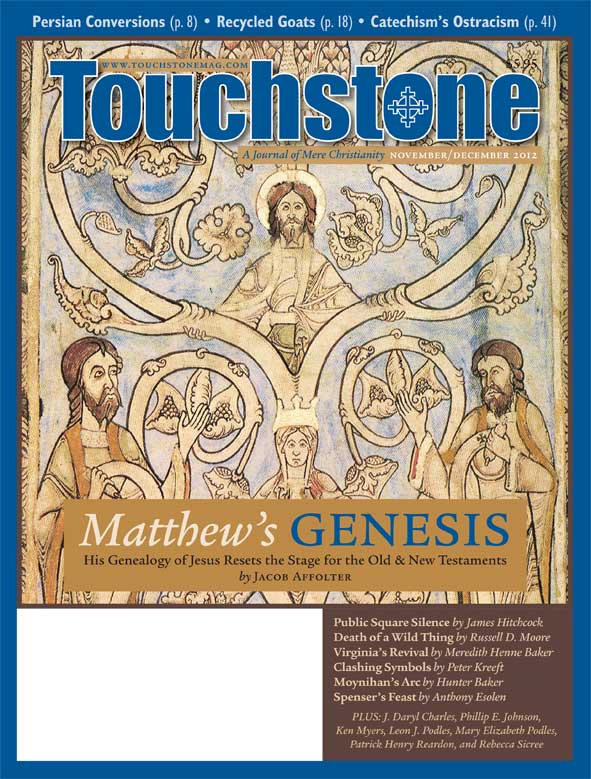Feature
Matthew's Genesis
The Genealogy of Jesus Resets the Stage for the Old & New Testaments by Jacob Affolter
I once heard a pastor say that many people resolve to read the entire New Testament but never get past the genealogy in the Gospel according to Matthew. I am sure that many readers consider this chapter among the least accessible parts of the New Testament. They may wish that Matthew had simply stated that Jesus Christ was "the Son of David, the Son of Abraham," and then gone straight on to the Nativity story.
While I sympathize with these readers, I believe it would be a serious mistake to skim through this genealogy. It is not merely a list of names or a legal document. Nor does it simply give a bit of background to the story of Christ's Nativity. Rather, it shows us how to understand Matthew's entire Gospel—and through it all of history—in the light of Christ.
A Poetic Structure
The first thing to notice about the genealogy is that it is not just a list. Rather, it is a highly structured literary arrangement. One reason people find it tedious is that they treat it as straight prose, when they should treat it more like a poem. To see this, try reading the passage slowly and evenly, taking special care not to push through the paragraphs that frame the list. If you do this, you can see that there is a rhythmic quality to the passage. The list itself moves at a slow, formal pace, punctuated by short paragraphs that put the list of names in a larger context.

On this point, it is instructive to contrast the genealogy in Matthew's Gospel with the one in Luke. In chapter 3 of his Gospel, Luke simply gives us a matter-of-fact list of names. Literally translated, Luke says, "Joseph of Heli of Matthat of Levi of Melchi . . ." and so on (Luke 3:23–24). In contrast, Matthew says, "Abraham begot Isaac, and Isaac begot Jacob, and Jacob begot Judah and his brothers . . ." (Matt. 1:2). Matthew deliberately draws the genealogy out, for reasons I will discuss in the next section.
The second point to notice is that the genealogy is interrupted by small insertions. Matthew takes care to set up a very steady rhythm, and then, at certain points, he deliberately breaks it. He does this primarily by adding an extra detail about a particular person in the list. For example, when he writes that "Boaz begot Obed," he adds "by Ruth" (Matt. 1:5). Through these small interruptions, Matthew draws our attention to specific features of the genealogy that he wants to emphasize.
Third, after neatly wrapping itself up with a closing line about the three groups of fourteen generations, the genealogy immediately leads into a passage with a very different style. Whereas the genealogy is almost poetry, the Nativity story that follows is told in straightforward narrative prose.
I submit that these structural features are not accidental. On the contrary, they provide clues as to how we should understand both the genealogy itself and the entire Gospel according to Matthew.
The New Genesis
The first theme I would draw from the structure of the genealogy is that Matthew is presenting his Gospel as the "new Genesis." Note, for instance, that both the genealogy and the Nativity story start out with some form of the Greek word genesis: the genealogy by saying, "The book of the genealogy (geneseos) of Jesus Christ . . ." (1:1), and the Nativity story by saying, "Now the birth (genesis) of Jesus Christ was as follows . . ." (1:18). In telling us that we are reading about a beginning, these phrases immediately bring to mind the opening words of the Old Testament Book of Genesis: "In the beginning God made heaven and earth."
Jacob Affolter is a lecturer in applied ethics in the Department of Philosophy at the University of Kentucky. He holds a Ph.D. in Philosophy from the University of California at Riverside. He attends an Eastern Orthodox parish in Lexington, Kentucky. Questions and comments are welcome and can be addressed to Dr. Affolter at jaffo001@ucr.edu.
bulk subscriptions
Order Touchstone subscriptions in bulk and save $10 per sub! Each subscription includes 6 issues of Touchstone plus full online access to touchstonemag.com—including archives, videos, and pdf downloads of recent issues for only $29.95 each! Great for churches or study groups.
Transactions will be processed on a secure server.
more from the online archives
calling all readers
Please Donate
"There are magazines worth reading but few worth saving . . . Touchstone is just such a magazine."
—Alice von Hildebrand
"Here we do not concede one square millimeter of territory to falsehood, folly, contemporary sentimentality, or fashion. We speak the truth, and let God be our judge. . . . Touchstone is the one committedly Christian conservative journal."
—Anthony Esolen, Touchstone senior editor











